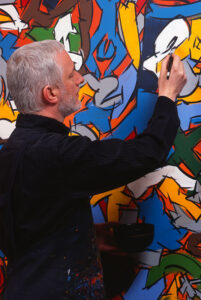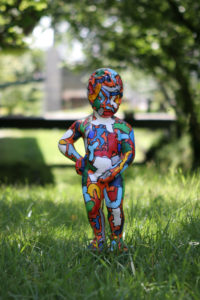Message
Who am I and what is my journey?
By Patrick Gerola
 Born in the heart of Brussels on June 28, 1959, I breathed art from my earliest days. Painting became my entire life, a legacy from my mother Irène, poet and painter, who initiated me into this world very early. Beautiful and inspiring, she not only created but also posed for many artists, including Léon Pringels, professor at the Academy of Fine Arts in Saint-Gilles.
Born in the heart of Brussels on June 28, 1959, I breathed art from my earliest days. Painting became my entire life, a legacy from my mother Irène, poet and painter, who initiated me into this world very early. Beautiful and inspiring, she not only created but also posed for many artists, including Léon Pringels, professor at the Academy of Fine Arts in Saint-Gilles.
As a child, I often wandered through the Marolles district, where the shadow of Pieter Breughel still lingered. Under the guidance of Agnès Dekrom, my teacher, I immersed myself in the work of this master who quickly fascinated me. Together we walked in the countryside of Vlazendaal, near Brussels, following the artist’s footsteps, contemplating the landscapes he had immortalized with such finesse.
On rainy Sundays, I took advantage of free admission to the Royal Museum of Fine Arts to immerse myself in the works housed there, lingering particularly before Breughel’s paintings, trying to unravel all their mysteries.
My path was set. I naturally entered the Royal Academy of Fine Arts, in Marianne Dock’s class, to perfect my training.
Then came 1981. Attending a performance of “Cinderella” at the La Monnaie theater, I was struck by artistic lightning. I joined “Mudra,” Maurice Béjart’s ballet school, as a scenographer. There I discovered a three-dimensional universe where dance, music, and painting converged, and worked alongside Micha Van Hoecke, director of the school and choreographer of the company ‘L’Ensemble’.
In 1983, I left for Japan with a Japanese dancer from this company. This journey, planned for a few months, confronted me with a fascinating world, radically different from what I had always known. I felt as if I had stepped “through the looking glass.”
There I met Tomomi, a Japanese lyrical artist who became my wife. Tokyo and its frenetic rhythm have been my home port for ever forty years, with a twelve-year interlude in Kamakura, a historic village on the outskirts of the capital.
Today, I pursue my career as a painter in Japan, with brief returns to Belgium, along the Damme canal where I maintain an anchor. My life unfolds this way, guided solely by my sensitivity and feelings.
I paint... but how?

My technique sometimes bewilders! I make my colors from pigments used in traditional Japanese “Nihonga” painting, mixed with tree resin according to my own formula. This method gives my hues a unique transparency and striking vitality.
This approach isn’t new: the first cave artists already used it, creating their colors from clay, plants, and natural elements. They painted on damp walls and dried their works using torches – a technique known as “Al Fresco.”
This method had disappeared because colors had to be prepared just before use and varied with the seasons. Rediscovered in the 19th century and revived by Italian art schools, it was my older brother Jean-Marie, also a painter living in Italy, who passed it on to me.
My collaboration with the dance world profoundly influences my way of painting. Each movement, rhythmed by music, guides my brush on the canvas. It vibrates and dances as in a choreography, transforming each painting into a scene from a performance.
I also draw inspiration from the “chiaroscuro” dear to Caravaggio. He painted by candlelight to better master colors in the shadows. Working in this near-darkness generates much more luminous tints than the often dull ones produced in studios flooded with light. My colors dominate the canvas!
Take my painting “Creation”: a field of poppies bathed in sunlight where you can feel the warmth and vitality of each flower. On the horizon, a cobalt blue sky merges with the sea, evoking freedom and hope. Each flower sings and dances in a visual concerto. The lines sometimes sketch violins, sometimes bayonets vanishing in the distance…
In “Moonlight,” the same landscape appears under night light. The flowers become blue while the sky blazes with a bright red at sunset. A demonstration that the colors of the same place metamorphose at every moment according to the play of light.
And what about my giant “Manneken-Pis” that appear in my works? Why transpose some of my paintings onto these 2.20-meter sculptures?
As a child, I met tourists surprised by the small size (62 cm) of the famous Brussels symbol. I decided to offer them a version that matched their expectations! These living paintings are a friendly and popular tribute to my country of origin, a faithful evocation of my roots.
My art reflects my philosophy

The relationship between nature and humanity sometimes reveals moments when trees seem to share their emotions with us. This experience profoundly transforms those who experience it.
My inspirations spring directly from nature and its light. They materialize in my canvases as movements, sounds, and colors. One must capture the atmosphere, listen to the birds, feel the caress of the wind, paint with heart and soul. Represent a landscape as one feels it, without being influenced by trends and artistic currents too often dictated by the art market.
Contemporary art follows two distinct paths: one creates on foundations anchored in tradition, the other seeks to break conventions without regard for forms and colors.
I believe that art which has belonged to the past has a future. The art of the present exists only in the moment and disappears with it. Once, artists were craftsmen who did not cheat. A landscape or portrait was painted, and the result had to speak for itself.
Today, the art market often persuades us that art is complex to understand. Yet, facing a landscape, everyone can judge whether they find it beautiful. As with food: we appreciate… or not! Art is felt with the heart and senses. We like it… or we don’t!
Painting implies great responsibility. We project our energy into others’ lives through our feelings. That’s why harmony with oneself is essential.
Forms and colors are remedies to beautify life. In our modern world where we contemplate nature less and less, it becomes imperative to neutralize harmful waves, absorb positive ones, and humanize our relationship with the world.
Such is my philosophy.
And the gaze of others?
What nourishes my work most is the gaze of others – their testimonies, their letters after an exhibition.
Sometimes I meet people whom pictorial art had never touched before. I later learn that they felt the need to discover other works, other painters, other exhibitions.
For an artist, isn’t this the most beautiful recognition?
A painting can transmit happiness or serenity. It can also reveal its creator’s suffering. Authenticity is crucial, and the public always perceives it.
Becoming aware of this oneself constitutes one of the keys to success.